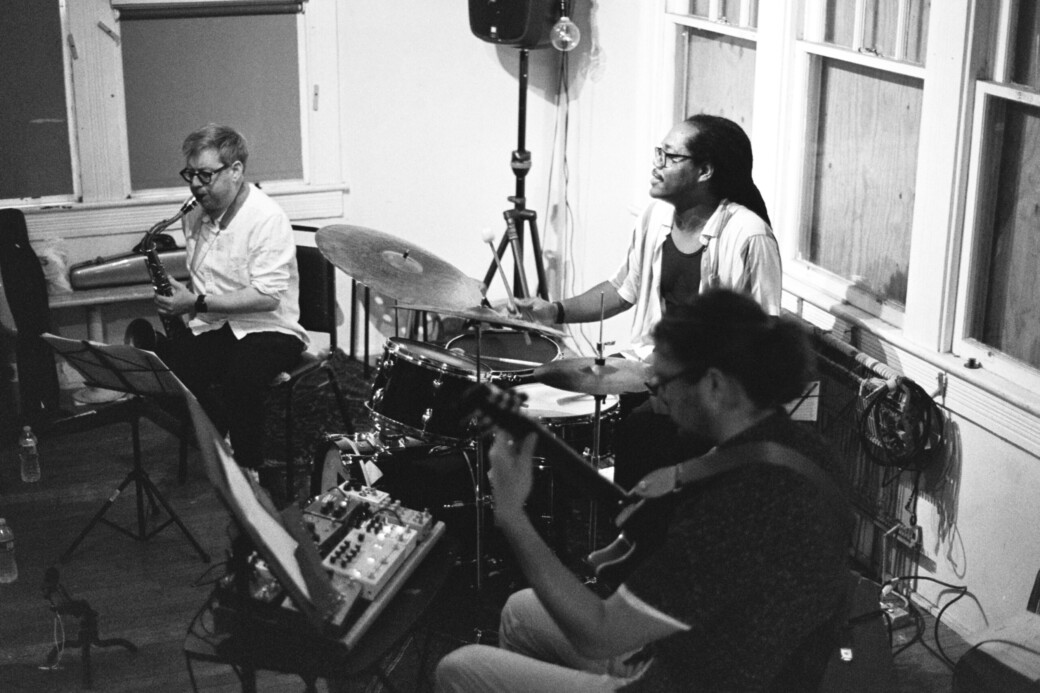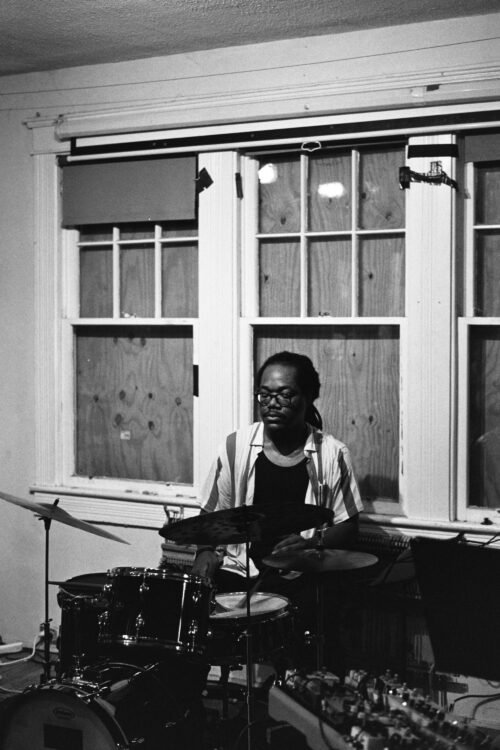On ‘everything at once,’ hypnotic trio Dream Feeder builds a world of gentle nurturing

You could be forgiven for drifting off at Dream Feeder’s record release show this past Tuesday night at Rhizome. This is not because the music off of everything at once, the trio’s debut album, is dull or stultifying but rather because its very nature invites tranquility, mediation and an atmosphere of peace in our increasingly offsetting world. More than that, the trio, consisting of the prolific saxophonist Brad Linde, guitarist Nelson Dougherty and drummer Keith Butler Jr. – the latter two of whom are close collaborators across multiple projects including Butler’s own trio, Steve Arnold’s Sea Change and jazz-punk band ¡FIASCO! – writes and performs music that seems intrinsically designed for this lulling atmosphere.
The group’s name, and the title of one of the tracks, came by way of Dougherty and from the concept of “dream feeding,” the act of feeding a newborn child while they are still slumbering. While all three members wrote tracks for the album, Dougherty, who was in the midst of raising his own child while working on material for the record, has the lion’s share of originals, and seems to have set the aesthetic tone for the group through that lens of gentle nurturing.

Take the album’s title track, “Everything at Once,” a Butler composition. In the head, Linde plays a warm, drifting melody on the tenor as Butler’s brushes gently nudge the rhythm along and Doughtery plays a simple riff on the guitar that mostly sees him alternate between two notes. The overall effect is a sonic rock-a-bye, setting the listener out to sea under a canopy of endless stars. As Linde begins to solo, the trio breaks out of the pattern and pushes forth, almost in a weave of collective improvisation, as both Butler and Dougherty play new melodies too, which themselves also twist and morph to buttress the lead improviser.
Indeed, for as much serenity as the trio cultivates in its tone, each song unfolds with deep dynamic range, with Linde’s playing in this setting often reminiscent of the kind of radiant but unhurried and inviting one Pharoah Sanders used with Floating Points on their album Promises and Dougherty’s arsenal of guitar pedals and effects creating soft fireworks of cascading effects. The follow-up track to “Everything at Once,” Dougherty’s “Leave It Alone,” feels like the liminal space between dreaming and waking – as in dream feeding – at the outset, as Linde’s saxophone sighs out warm phrases amidst Dougherty’s dreamy, reverb-soaked mix of effects builds hallowed organ-like landscape underneath. In the middle of all that cuts Butler, whose stick- and brush-work dances across seemingly every inch of the kit in a driving countermelody.

The tension that Butler’s playing provides underlies much of the trio’s music. Though at times buoyant, the drummer always provides a concrete solidity to cut through the swirl of Linde and Dougherty’s conjurations.
For the release party at Rhizome – which occurred earlier this month – the group played the whole album top to bottom, leaning hard into the atonal, angular movements alongside the dream questing found elsewhere on the record. “Ugly Cry,” another Dougherty tune, was such, featuring skittering runs up and down the soprano saxophone by Linde paired with eerie tones from the guitar. From there the piece oscillated between passages full of the ease and drift of the trio’s central sound to moments with more lean and spare melodies. At the song’s climax the three musicians hit a tone together that rang out with the sonic equivalent of that perfect sunbeam emerging from the cracks between the darkest clouds, that delicious moment where the dream was as good as it could be.
Not an escape from waking, but a reimagining of reality into a twinkling new form.
Disclosures:
Keith Butler Jr. is CapitalBop’s unofficial staff photographer and did not have any editorial role in the assignment or execution of this piece.
Jamie Sandel, CapitalBop’s creative media lead, is credited with the session photos for the recording of everything at once and similarly played no editorial role in this piece.
Brad Linde, DC, DC jazz, jazz, Keith Butler, Nelson Dougherty, Rhizome DC, Washington




